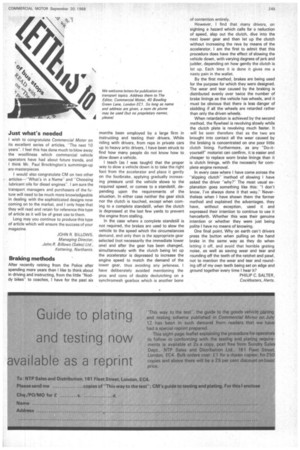Braking methods
Page 249

If you've noticed an error in this article please click here to report it so we can fix it.
After recently retiring from the Police after spending more years than I like to think about in driving and instructing, from the little "Noddy bikes" to coaches, I have for the past six months been employed by a large firm in instructing and testing their drivers. While riding with drivers, from reps in private cars up to heavy attic drivers, I have been struck to find how many people do not know how to slow down a vehicle.
teach (as I was taught) that the proper way to slow a vehicle down is to take the right foot from the accelerator and place it gently on the footbrake. applying gradually increasing pressure until the vehicle slows to the required speed, or comes to a standstill, depending upon the requirements of the situation. In either case neither the gear stick nor the clutch is touched, except when coming to a complete standstill, when the clutch is depressed at the last few yards to prevent the engine from stalling.
In the case where a complete standstill is not required, the brakes are used to slow the vehicle to the speed which the circumstances demand, and only then is the appropriate gear selected (not necessarily the immediate lower one) and after the gear has been changed, simultaneously with the clutch being let up the accelerator is depressed to increase the engine speed to match the demand of the lower gear, thus avoiding any jerkiness. I have deliberately avoided mentioning the pros and cons of double declutching on a synchromesh gearbox which is another bone of contention entirely.
However, 1 find that many drivers, on sighting a hazard which calls for a reduction of speed, slap out the clutch, dive into the next lower gear and then let up the clutch without increasing the revs by means of the accelerator. I am the first to admit that this procedure does have the effect of slowing the vehicle down, with varying degrees of jerk and judder, depending on how gently the clutch is let up. Each time it is done it gives me a nasty pain in the wallet.
By the first method, brakes are being used for the purpose for which they were designed. The wear and tear caused by the braking is distributed evenly over twice the number of brake linings as the vehicle has wheels, and it must be obvious that there is less danger of skidding if all the wheels are retarded rather than only the driven wheels.
When retardation is achieved by the second method, the flywheel is revolving slowly while the clutch plate is revolving much faster. It will be seen therefore that as the two are brought into contact all the wear caused by the braking is concentrated on one poor little clutch lining. Furthermore, as any "Do-ityourself" motorist can confirm, it is easier and cheaper to replace worn brake linings than it is clutch linings, with the necessity for complete engine removal.
In every case where I have come across the "slipping clutch" method of slowing I have asked the driver "why?" The most usual explanation goes something like this: "I don't know, I've always done it that way." Nevertheless when I have shown them the former method and explained the advantages, they have, without exception, used it and expressed their intention to continue to use it henceforth. Whether this was their genuine intention or whether they were just being polite I have no means of knowing.
One final point. Why on earth can't drivers press the button when pulling on the hand brake in the same way as they do when letting it off, and avoid that horrible grating noise, as well as saving wear and tear and rounding off the teeth of the ratchet and pawl, not to mention the wear and tear and rounding off of my own teeth being set on edge and ground together every time I hear it?
PHILIP C. SALTER, Cockfosters,


















































































































































































































































































































































































